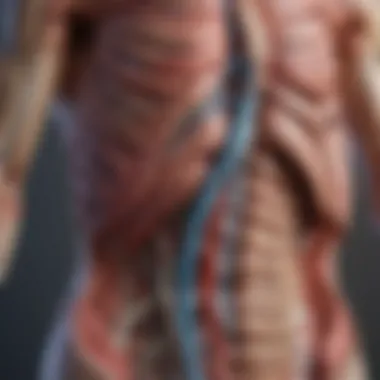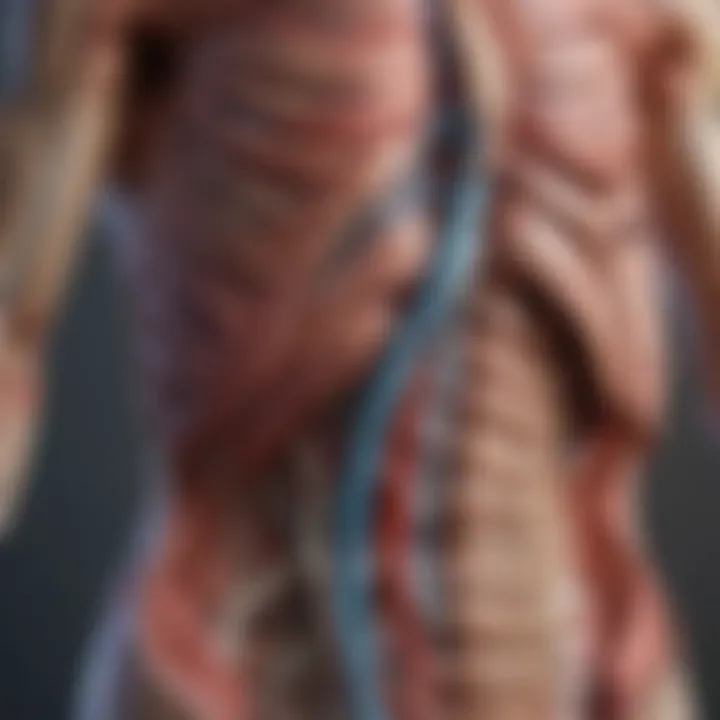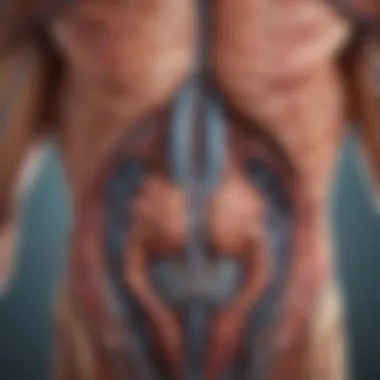Exploring Bill Bryson's 'The Body': Insights and Humor


Intro
In the realm of literary explorations of the human body, few authors blend knowledge and wit quite like Bill Bryson. His book, The Body: A Guide for Occupants, offers readers a profound journey into the intricacies of human anatomy and physiology. Bryson, known for his engaging narrative style, breaks down complex scientific concepts into digestible pieces infused with charm and humor. This exploration aims to shed light on the remarkable machine that is the human body while simultaneously sparking a deeper appreciation for our biological wonders.
Bryson’s work stands as more than just an informative read; it’s a celebration of life, a reflection on how our bodies function, and a reminder of the marvel that is being human. Through this article, we will navigate the key concepts and insights found in his book, while also identifying practical applications and offering some recommendations for further reading.
Key Concepts and Insights
Main Ideas from the Book
One of the striking features of The Body is how Bryson deftly weaves together stories about anatomy with relatable anecdotes. He explores various organ systems, revealing astonishing facts. For instance, did you know that the human nose can distinguish over a trillion smells? Or that the average person sheds about 40 pounds of skin in a lifetime? These tidbits not only inform but also engage readers, prompting them to think differently about their own bodies.
Bryson underscores critical concepts in human biology, such as:
- Cellular structure and function: Bryson explains how cells operate as the basic units of life, akin to tiny factories. He describes their roles in repair and regeneration, offering insights on how they impact our overall health.
- The immune system: A fascinating component where he details how our body’s defenses work tirelessly to fend off invaders. His storytelling illuminates the remarkable adaptations and strategies employed by immune cells.
- The brain’s complexity: Bryson skims the surface of neuroscience, hinting at the brain's vast capabilities and the mysteries surrounding consciousness and memory.
Practical Applications of Concepts
The knowledge Bryson provides extends beyond mere information. It has a tangible impact on our daily lives and health choices. For example:
- Understanding nutrition: With insights into digestion and metabolism, readers can better appreciate the connection between diet and bodily functions, allowing for informed choices that foster well-being.
- Emphasizing mental health: By exploring brain functions and their emotional tie-ins, Bryson advocates for a holistic view of health that includes mental wellness as an integral component of overall health.
- Promoting self-care: Recognizing the body's functions encourages individuals to engage more actively in their health, whether through exercise, diet, or regular check-ups.
Bryson’s prose demystifies science, making it accessible to those without a background in the field. In doing so, he fascinates and educates simultaneously.
Recommendations and Further Reading
Related Books to Explore
For those captivated by Bryson’s approach, several other texts delve into anatomy and health in engaging ways:
- Sapiens: A Brief History of Humankind by Yuval Noah Harari – Although not strictly about biology, it offers insights into our species’ evolution.
- The Anatomy of Human Destructiveness by Erich Fromm – A deep dive into the darker aspects of human nature from a psychological perspective.
- The Body Keeps the Score by Bessel van der Kolk – This book explores the interplay between trauma and physical health, adding a vital dimension to body awareness.
Additional Resources for Personal Development
Exploring personal health further can include:
- Online courses on human anatomy available at platforms like Coursera and edX.
- Health-focused podcasts that discuss body health and wellness. One such popular podcast might be The Doctor’s Farmacy by Mark Hyman.
- Engaging in community health workshops can provide real-life applications of concepts discussed in literature.
By immersing oneself in the broad landscape Bryson paints in The Body, along with recommended readings and resources, a reader can cultivate a richer appreciation for the human experience.
Overview of Bill Bryson's Work
Understanding Bill Bryson's work is vital for grasping the essence of his book, "The Body: A Guide for Occupants". Bryson's literary oeuvre is marked by a distinctive knack for making complex subjects approachable and enjoyable. This section shines a light on his journey, not just as a writer but also as a keen observer of the human experience, crafting a bridge between knowledge and entertainment that resonates with readers across the globe.
A Brief Biography
Bill Bryson was born in 1951 in Des Moines, Iowa. He later move to England, where his career took a definitive turn. As an American living abroad, Bryson frequently found himself at the crossroads of culture, often using those experiences to imbue his writing with both humor and insight. Throughout his career, he has carved a niche for himself, blending personal anecdotes with factual information in an engaging manner. Among his wide-reaching works, titles like "A Walk in the Woods" and "A Short History of Nearly Everything" stand out. They reflect his undeniable curiosity and his unique perspective towards the world. This background plays a crucial role in how he addresses subjects such as science and health in "The Body".
Literary Accomplishments
Bryson's literary achievements are numerous and reflect his versatility. His ability to engage a wide audience is one of his most notable skills. Here are some highlights:
- "A Walk in the Woods": This book chronicles his journey along the Appalachian Trail, rich with humor and observations about the outdoors.
- "A Short History of Nearly Everything": This scientific book simplifies complex concepts, making them digestible for all, while still challenging readers’ thinking.
- "The Mother Tongue": An exploration of the English language, showcasing Bryson's incredible ability to make language itself a source of fascination.
Additionally, Bryson has received various awards, reinforcing his status in the literary realm. His contributions not only entertain but also educate, significantly impacting how readers perceive topics ranging from nature to science. Bryson’s narrative style offers a mix of humor and education, and his thorough research behind each topic reinforces the credibility of his works. As readers dive into "The Body", it's essential to understand Bryson’s foundational principles as a writer, as they enrich the context and understanding of his insights into the human anatomy.
Prologue to The Body


In the realm of modern literature, few authors manage to intertwine humor and science with such finesse as Bill Bryson in his work The Body: A Guide for Occupants. This section seeks to define the significance of Bryson's exploration of the human body, shedding light on its thematic relevance and the layered insights he provides.
Bryson's writing transcends mere observation; it invites readers to embark on a journey of self-discovery through the anatomy that houses their very being. By marrying detailed scientific knowledge with relatable anecdotes, he not only informs but captivates his audience. This dual approach positions the book as both a reference guide for those intrigued by human biology and a compelling read for the casual browser.
One might wonder, why delve into a subject like human anatomy? In an age where information is at our fingertips, understanding the intricacies of the body can significantly impact our health and wellness decisions. Engaging with Bryson's narrative encourages reflection on our own bodies, inspiring a sense of responsibility and curiosity about how they function and what keeps them healthy.
The Inspiration Behind the Book
Bill Bryson's The Body finds its prowess in the author’s genuine passion for the subject matter. What drove him to explore human anatomy? A nagging curiosity, as he expressed often, about how his body operates. In an interview, he mentioned that he feels much like the average person who operates on autopilot without considering the marvel of their biological systems.
He dived into the whimsical facts, startling statistics, and everyday miracles of the human body. For example, he surprises his readers with the fact that humans share a significant amount of DNA with bananas. This juxtaposition alone illustrates Bryson’s knack for simplifying the complex and, frankly, making the reader chuckle while learning.
Target Audience and Purpose
Bryson's The Body caters to a diverse audience, from students striving to grasp anatomy concepts to adults pondering the intricacies of their own physicality. The book is designed for anyone who has ever looked at themselves in the mirror and wondered, "What’s going on under the surface?"
The purpose of this book extends beyond mere information. Bryson aims to demystify the science of the human body, turning what could be overwhelming topics into digestible narratives. He weaves in humor, ensuring that readers remain engaged, transforming potentially dry scientific texts into lively discussions that spark intrigue.
Ultimately, Bryson serves a dual purpose here: to educate while simultaneously inviting readers to develop a symbiotic relationship with their own health. Readers finish the book with a newfound appreciation for the complexities of the body and, often, a greater inclination to ask questions about their own health and well-being.
Structure of The Body
Understanding the structure of Bill Bryson's The Body: A Guide for Occupants offers notable insights into how he organizes vast amounts of scientific knowledge into an engaging narrative that appeals to both laypersons and aficionados of science. One cannot underestimate the importance of the organizational framework in such a complex subject as human anatomy. Bryson's careful chapter breakdown and thoughtful flow not only guide the reader through the intricacies of our body but also highlight key concepts in a way that feels fluid rather than overwhelming.
Chapter Breakdown
Bryson's approach to chapter organization reflects a keen understanding of the reader's journey through the text. Each chapter functions almost like a mini-journey exploring different facets of the human body. This compartmentalization allows for focused exploration without excessive cognitive overload. For instance, starting with broad inquiries about the significance of the body, Bryson narrows down progressively to specific organisms and systems.
- The Inception of Each Chapter: Each chapter opens with intriguing questions or startling facts that captivate the attention of the reader. This method ensures that readers are hooked from the outset, inviting them to delve deeper.
- Thematic Grouping: Bryson smartly groups related subjects under a wider narrative umbrella. By drawing connections between seemingly disparate elements of anatomy, he fosters a holistic perspective on how various systems interplay.
- Layered Complexity: As the chapters progress, Bryson deepens the complexity of the subject matter, but he does so in an accessible manner. New concepts are gradually introduced, building off previously established ideas, which is crucial for maintaining engagement.
A prime example shows in how he initiates discussions about systems like digestion or respiration not just at a physiological level but also introduces historical anecdotes that make these systems relatable.
Flow and Cohesion
The seamless flow of Bryson’s narrative plays a pivotal role in keeping readers engaged. Each chapter transitions smoothly into the next, ensuring a cohesive reading experience. Bryson achieves this through various techniques:
- Narrative Threads: He employs recurring motifs and ideas that weave throughout the chapters. This creates a sense of unity and allows the text to feel interconnected.
- Contextual Backdrops: Each chapter not only focuses on anatomical structures but frequently relates them to everyday life. This approach positions the scientific facts in relevant contexts, allowing readers to connect more personally with the material.
- Engaging Language: The language Bryson uses is neither pedantic nor overly simplistic. He strikes a balance that invites curiosity while educating the reader, exhibiting traits that appeal to a broad audience.
In the words of Bryson himself, "It’s an astonishing fact that human beings are incredibly intricate, like a Swiss watch, with a history that’s as complicated as its inner workings."
In essence, Bryson's mastery of structure and cohesion transforms The Body into a fascinating read, making complex topics digestible. His thoughtful organization enhances the reading experience, anchoring the exploration of anatomy in a way that is as enlightening as it is entertaining.
Thematic Analysis
In analyzing Bryson's work in "The Body: A Guide for Occupants," one cannot overlook the rich tapestry of themes woven throughout the text. This thematic analysis serves as a lens through which readers can better appreciate both the insights presented and the underlying messages. The exploration of human anatomy goes well beyond mere descriptions of bodily functions; it seeks to convey a deeper understanding of our existence and how we relate to the marvel that is the human body.
Exploration of Human Anatomy
Bryson's approach to human anatomy is not simply instructional but rather an invitation to understand oneself at a more profound level. He does not just catalogue organs and scientific terms; instead, he breathes life into these concepts. For instance, when discussing the heart, Bryson illustrates its significance not merely as a pump but as a central component of our being, intertwined with emotions and life experiences. His storytelling makes complex systems approachable. The surprising facts he presents, such as how the liver functions almost as a mini-factory producing enzymes, highlight the body's complexity in a digestible manner. Readers are left with a newfound appreciation for the intricacies of their own bodies, sparking curiosity and contemplation about their everyday health and experiences.
Life and Mortality
Life and mortality are ever-present themes in Bryson's exploration, often intertwined in a dance as old as humankind itself. He takes us through the journey of existence, addressing our eventual fate with a matter-of-fact demeanour that is both enlightening and poignant. For instance, Bryson delves into how our understanding of the human lifespan has evolved, reflecting societal attitudes towards health, illness, and the aging process. By weaving personal anecdotes and statistical data, he forces us to confront uncomfortable truths about mortality, making it less of a taboo subject and more an integral part of the human experience.
This theme resonates with many readers, prompting introspection about how best to live life fully amid the certainty of its end. Recognizing the precariousness of life can encourage individuals to be more mindful and proactive about their health, fostering discussions that may otherwise remain unspoken.
Humor in Science
One of the standout features of Bryson's writing in this book is his ability to inject humor into the realm of science, making complex topics more relatable. Through witty observations and amusing anecdotes, he manages to lighten the gravity often associated with scientific discourse. Bryson’s style draws readers in, allowing them to engage with dense topics without feeling overwhelmed. For example, his commentary on how the human nose can identify a myriad of scents is interspersed with quirky facts and amusing analogies, creating a light-hearted narrative that makes learning enjoyable.


This clever use of humor emphasizes the joy of discovery rather than the fear of the unknown, helping demystify scientific concepts. With this approach, Bryson cultivates an environment where readers feel empowered to explore their curiosity rather than shun it. In a world where science can sometimes feel inaccessible, Bryson’s humor is a bridge into deeper comprehension.
"The best part about exploring the human body is the endless possibilities of discovery, blended with the laughter we experience along the way."
Key Concepts Presented
Understanding the key concepts presented in Bill Bryson's The Body: A Guide for Occupants is crucial for grasping the scope of the book. This section reflects on core topics regarding the functionality of major organs, the nervous and immune systems, and the human microbiome. Delving into these areas helps demystify the complexities of human anatomy and highlights how interconnected our bodily systems truly are. Bryson's narrative not only informs but offers a perspective that encourages readers to consider the intricate mechanics of their own bodies. The significance of these discussions stretches beyond mere awareness; it fosters a deeper relationship between individuals and their health.
Functionality of Major Organs
Major organs serve as the foundation upon which our physical existence is built. Bryson meticulously breaks down each organ—from the heart that pumps life-sustaining blood to the liver that detoxifies and metabolizes substances. He emphasizes:
- Heart: Often romanticized, yet its relentless work pulls from a network of arteries and veins, pushing blood through an extensive circulatory system that reaches every corner of the body.
- Lungs: They do more than just facilitate breathing; they play a crucial role in gas exchange, making them vital for survival.
- Kidneys: These bean-shaped organs regulate everything from electrolytes to blood pressure, proving crucial not just for waste elimination but for maintaining homeostasis.
Bryson’s vivid descriptions breathe life into these organs, allowing readers to appreciate not only their functionality but also the marvels of how they interact in harmony with one another. The way he portrays these organs gives readers a greater sense of wonder about their own bodies and the invisible processes that sustain them.
Nervous and Immune Systems
The nervous and immune systems are fundamental to our survival, and Bryson rightly dedicates significant attention to these systems. The nervous system, with its complex web of neurons, controls every movement and response. This intricate system can be likened to a finely tuned orchestra, where each neuron plays its role in synchrony. Some key insights include:
- Neurons: The basic units of the brain and nervous system that communicate via electrical impulses.
- Reflex Actions: Fastest reactions to stimuli, showcasing the efficiency of this system.
Equally impressive is the immune system, the body’s line of defense against pathogens. Bryson conveys how this system is not just reactive but also anticipatory, adapting to fend off invaders. Key points here are:
- White Blood Cells: The soldiers of the immune system, identifying and combating threats.
- Vaccination: A fascinating dialogue that Bryson engages in, emphasizing how immunization builds resilience against diseases before they strike.
The Human Microbiome
An emerging field of research that Bryson tackles is the human microbiome. This concept refers to the trillions of microorganisms living within and on us, and their role is far from trivial. They influence our health, digestion, and even mood. Bryson discusses:
- Diverse Ecosystem: The gut houses diverse bacteria, working symbiotically to aid digestion and protect against harmful bacteria.
- Mental Health Connection: The link between gut health and mental state focus on the intertwined fates of the brain and digestion, something often overlooked yet fundamental to our overall well-being.
In essence, the human body is not an isolated entity; it’s a bustling community of cells and microbes that collectively function in unison.
Bryson’s treatment of these concepts not only elucidates the significance of bodily systems but serves as a stepping stone for readers who wish to pursue a better understanding of their health on a broader scale.
Bryson's Narrative Style
Bill Bryson's storytelling is a craft that weaves wit and wisdom, making the complex realm of human anatomy far more accessible to a broad audience. His narrative style plays a crucial role in this work, illuminating dense information with clarity and engagement. The fusion of humor with factual content allows readers to digest scientific concepts without feeling overwhelmed. This blending of elements becomes not just a unique selling point but a vital tool for enhancing comprehension and retention of the material presented.
Voice and Tone
Bryson's voice throughout The Body oscillates between conversational and informative, offering a seamless reading experience. He manages to establish a familiar rapport with his audience, utilizing a tone that feels as if he’s explaining something fascinating during a casual coffee chat. For instance, he doesn't shy away from employing colloquial phrases like "kicking the bucket" when discussing mortality, which grounds the topic in everyday human experiences.
This deliberate choice of language humanizes the scientific discourse. Bryson’s tone does not eclipse the seriousness of the subject matter; instead, it promotes a sense of camaraderie, suggesting that the reader is embarking on this journey of discovery together with him. By balancing seriousness with levity, Bryson makes the science approachable without diluting its significance.
Use of Anecdotes
Anecdotes serve as Bryson's secret sauce, peppered throughout the text like spice in a well-cooked meal. They function on multiple levels: not only do they provide relatability, but they also illustrate and illuminate complex scientific concepts in a memorable way. For instance, when discussing the brain's functionalities, Bryson might recount a personal episode about forgetting someone's name at a gathering, turning abstract neural functions into an understandable and amusing narrative.
Smartly crafted anecdotes act as a bridge between the facts and the reader’s own life experiences. This connection helps demystify intricate topics, ensuring that readers are not just consumers of information but also active participants in the conversation. They hold the reader's attention, illustrating real-life implications of bodily functions, thus making the subject matter resonate even deeper.
Engagement through Curiosity
Another hallmark of Bryson's narrative style is his ability to spark curiosity. He poses thought-provoking questions throughout his exploration of the human body, nudging readers to engage with the material on a personal level. Phrasing inquiries like "Have you ever wondered how your body reacts to a sneeze?" not only piques interest but draws the reader in, making them ponder their own bodily processes.
This engagement strategy is critical. It transforms the reading experience from mere passivity into an interactive dialogue between writer and reader. By encouraging contemplation and self-reflection, Bryson creates a layered experience where readers don’t just learn; they become invested in the knowledge being presented.
"Curiosity drives us to explore the unknown, to bridge gaps in our understanding of ourselves."


Critical Reception
The critical reception of Bill Bryson's The Body: A Guide for Occupants plays an essential role in appreciating the author's insights into human anatomy and the complexities of our biological systems. Critics and readers alike have weighed in, and their perspectives offer valuable layers of understanding regarding both Bryson's narrative style and the scientific content he presents.
Bryson manages to meld humor and knowledge, creating an accessible platform for audiences of all backgrounds. The way he tackles intricate subjects, like the immune system or human microbiome, distinguishes his work not just from dry textbooks, but also from more conventional popular science books. Critics commend his ability to simplify complex medical jargon without diluting the scientific accuracy. His prose flows smoothly, pulling readers along, often prompting them to rethink previously held misconceptions about their own bodies.
Literary Critiques
Critiques from literary circles often highlight Bryson's knack for storytelling. Many reviewers found that he transforms what could easily become a daunting subject into an engaging narrative. For instance, his unique ability to inject personal anecdotes creates relatable moments, allowing readers to connect deeply with abstract biological concepts. Some key points from critiques include:
- Engaging Style: Critics frequently mention Bryson's skillful use of language to sustain reader interest. His conversational tone resonates well, making scientific information digestible.
- Anecdotal Evidence: Incorporating personal stories makes the material feel less like a lecture and more like a chat with a knowledgeable friend. This aspect appears to create a more profound interest in the subject matter.
- Balanced Viewpoint: Many critiques note that he presents topics without bias. Bryson discusses both the marvels and the shortcomings of human biology, encouraging readers to foster their own opinions on health matters.
Reader Responses
Reader feedback often mirrors that of critics but comes with a unique, personal touch. Many readers have expressed their appreciation for how Bryson has made them rethink their understanding of their own bodies, sparking a newfound curiosity about anatomy. Here are a few noteworthy aspects from reader responses:
- Increased Awareness: Numerous readers report that the book has led them to adopt healthier habits, driven by a better understanding of bodily functions. They cite specific examples from the book, such as the workings of the heart and lungs, as revelations that prompted lifestyle changes.
- Encouragement of Inquiry: The book inspires readers to delve deeper into topics of health and science. Many have taken to online forums to discuss their learnings, highlighting how Bryson's engaging style encourages a critical examination of both personal and societal health concerns.
- Accessibility of Information: Readers commend Bryson for his ability to demystify complex topics. They appreciate that he doesn’t talk down to them, making advanced concepts approachable and inviting a wider audience to explore science.
“Bryson’s writing is like a bridge between complex science and everyday understanding. It equips you to tackle matters that you once regarded with skepticism or confusion.”
The reception from both critics and readers showcases a cognizant awareness of Bryson's prowess in balancing science and narrative. His approach, praised for its engaging tone and accessible information, underscores the impact of The Body as not just a book about anatomy, but as a catalyst for deeper health-related conversations among a diverse audience.
Impact on Personal Health Perspectives
Understanding one's personal health is more critical today than ever before. In his book, Bryson navigates through the complexities of human anatomy and physiology, shedding light on intricate systems and functions that many often take for granted. This section unpacks the various ways Bryson's work affects individual viewpoints on health and wellness.
Health Awareness
Bryson's enlightening journey through the human body fosters a greater health awareness among his readers. By presenting facts about how our body operates, he pushes the audience to acknowledge that healthy living is not just a choice but an informed decision.
He lays out the intricate connection between lifestyle choices and bodily functions. For example, he discusses the impact of diet on the immune system.
- Increased intake of fruits and vegetables can bolster one’s immune response.
- Physical activity supports cardiovascular health.
This not only encourages a proactive approach to health, it also motivates readers to rethink habits that may be detrimental. Bryson includes fascinating anecdotes about individuals who successfully altered their lifestyles.
"It’s easier than we think to take charge of our own well-being; we just need the right information to do so"
The Body, Bill Bryson.
Encouragement of Scientific Literacy
Bryson's narrative does not just stop at fostering awareness; it extends into encouraging scientific literacy. He offers readers the tools to understand health information critically, empowering them to differentiate between facts and misinformation in today’s digital age.
By simplifying complex biological concepts into digestible chunks, Bryson enables individuals to grasp the biochemical interactions that take place within their bodies—knowledge that can be particularly useful when curating dietary choices or understanding medical advice.
Consider how Bryson illuminates topics like the human microbiome. Learning about
- the role of gut bacteria in overall wellness
- how this impacts conditions like IBS or obesity
This knowledge arms readers with the understanding necessary to embrace or question proposed health directives. Such a foundation in scientific literacy cultivates a population that does not just consume health narratives but actively engages with them, fostering a culture of inquiry.
Ending
In wrapping up the exploration of Bill Bryson's The Body, it’s clear that this book goes beyond mere anatomy. Bryson invites readers to engage with the human body not just as a collection of parts and processes, but as something intimate and extraordinary. The connection between knowledge and empathy is pivotal; when people understand how their bodies function, they may develop a greater respect for the intricate systems that enable life.
Final Thoughts on The Body
The Body serves as a celebration of human existence. Bryson's ability to weave humor and scientific fact makes for a compelling narrative that enlightens while also entertaining. Each chapter offers readers insight into bodily functions that might otherwise go unnoticed in day-to-day life. It’s not merely educational—it’s eye-opening.
The text is crafted carefully, ensuring that readers of all backgrounds can grasp complex ideas without feeling overwhelmed. Bryson effectively removes the intimidation factor often linked to scientific texts, making the experience feel like a chat over coffee rather than a stuffy lecture. His anecdotes, often laced with wit, serve to highlight the absurdity and wonder of our biology.
Legacy of Bryson's Work
Bryson has a penchant for transforming the mundane into the marvelous. His contributions to literature, especially concerning science, have left a lasting impression. By demystifying the human body, he empowers readers to approach health and anatomy with curiosity rather than fear. This impact is significant, as the understanding of our bodies is a crucial piece of living well.
Moreover, Bryson’s books encourage critical thinking about scientific issues in a world rife with misinformation. This legacy is essential, particularly for young readers and those seeking to deepen their comprehension of how science interfaces with daily living. In a nutshell, Bill Bryson has not merely authored a book; he has fostered a dialogue about the very essence of what it means to be human.







